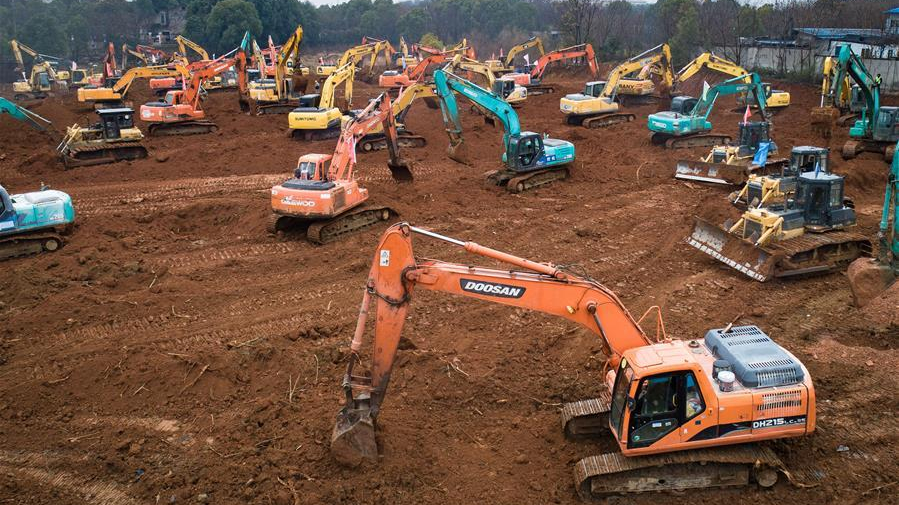
Aerial photo taken on January 24, 2020 shows mechanical equipment working at the construction site of a special hospital in the Caidian District of western suburb of Wuhan, central China's Hubei Province. /Xinhua Photo
Aerial photo taken on January 24, 2020 shows mechanical equipment working at the construction site of a special hospital in the Caidian District of western suburb of Wuhan, central China's Hubei Province. /Xinhua Photo
Editor's note: Tom Fowdy is a British political and international relations analyst and a graduate of Durham and Oxford universities. He writes on topics pertaining to China, the DPRK, Britain, and the U.S. The article reflects the author's opinions, and not necessarily the views of CGTN.
As China responds to the coronavirus, it was announced that local authorities in Wuhan would construct a new hospital to handle the outbreak within a period of six days. The new facility is to prevent a strain on infrastructure in the city and to help better quarantine patients and will be equipped with around 1,000 beds. Chinese media had quickly released photos of diggers on the site, showing the unprecedented pace and seriousness as to how the situation was going to be approached. A hospital had also been created in similar circumstances in response to the SARS outbreak in 2003.
How can China build a hospital in six days? And is there any catch to this? This is one area where China differs from the West and may have an advantage. The country's political system allows for greater resolve and scope in decision-making processes, which can, in times of emergency, supersede conventional bureaucratic hurdles without issue, allowing faster mobilization and response.
Because land in Chinese cities is constitutionally owned by the government and privately leased to its people, this means emergency construction can be placed into action instantaneously, with the country's massive labor force making the building speed possible without any detriment to quality.
First of all, China's political system differs from Western plural societies in that it is more unified through its hierarchical order. China's system of one-party governance is based around the Leninist principle of democratic centralism whereby decisions made by the central government are relayed from the center to the various levels.
This process makes local governments in China more accountable and directly answerable to the central government, whereas, in Western society such as the UK, local authorities are largely autonomous from the central authorities and elected by their communities, meaning their agendas, outlooks, and decision-making vary significantly.

Veteran Engineer Wu Zhizhen works on site with his colleagues for building a new 1,000-bed hospital to treat patients with the new coronavirus in Wuhan City in central China's Hubei Province. /CGTN Photo
Veteran Engineer Wu Zhizhen works on site with his colleagues for building a new 1,000-bed hospital to treat patients with the new coronavirus in Wuhan City in central China's Hubei Province. /CGTN Photo
On this context, China has the ability to make faster and more resolute decisions in response to crisis and bypass traditional bureaucratic hurdles, taking necessary courses of action which may be objected to, resisted and branded unpopular in Western countries, slowing down the scope and options of a given response, for example, such as suspending public transport in affected areas or other emergency regulations. This also applies to the notion of construction, allowing contingency plans for a building to be approved almost instantly in contrast to bureaucratic hurdles of the West.
But still, how is this possible? First, China's constitution allocates urban land to be the property of the central government, save that it is leased to private owners and residents with the expansion of property reform. This means almost instantly, any space of unoccupied land can be found to construct a hospital and approved without issue and a need for consultation.
In the West, where all land is privately owned by default, this is impossible. In finding a site, the government secondly has the ability to rapidly mobilize any resources it needs to the given location and, thirdly, has the world's largest labor force to choose from to ensure enough hands are present to merit the building speed.
This, constructing a fully-fledged hospital in six days becomes bizarre, but truly possible and legitimate by Chinese standards. This does not, contrary to popular belief, come at the expense of quality either. As Huang Yanzhong, a Chinese scholar, told journalists: "The engineering work is what China is good at. They have records of building skyscrapers at speed. This is very hard for Westerners to imagine. It can be done." Thus, the hospital will be built and in operation, before we know it, with no likely snags or setbacks.
Therefore, as a whole, the rapid construction of the hospital should be understood as a government-led all society mobilization in response to a crisis. In contrast to Western pluralism, China is able to take more clear and resolute courses of action in order to protect public health, safety and contain the spread of natural disasters. Thus, what is needed to be done is done. The new hospital should speed up efforts to contain the coronavirus, and acts like this are bound to secure public confidence.
(If you want to contribute and have specific expertise, please contact us at opinions@cgtn.com.)